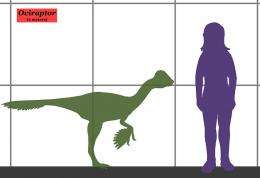A Peafowl flaring his feathers. Image: Wikipedia.
(PhysOrg.com) -- A new study presented at the Society for Vertebrate Paleontology shows that the Oviraptor dinosaur had a tail structure that allowed it to shake its tail feathers, possibly to attract potential mates.
Oviraptors roamed the Earth during the late Cretaceous Period. Their name, which is Latin for “egg thief,” was given to them because the first remains found of this dinosaur was discovered near a pile of eggs. However, as more were discovered it was determined that the eggs in fact probably belonged to the dinosaur. Researchers are still not sure what their exact diet would have consisted of.
Oviraptors are a member of the theropod group of dinosaurs. Their tail structure is similar to that of modern-day birds. Doctoral student Scott Persons from the University of Alberta was studying this group of dinosaurs when he discovered that the Oviraptors had a different and odd arrangement of bones in the tail.
Size comparison between the dinosaur Oviraptor and a human. Image: Wikipedia.
The tail structure of the Oviraptor is shorter than most other dinosaurs. He discovered that this short size was not because of missing bones but because each individual vertebra are compacted together. This dense arrangement of the bones makes the tails extremely flexible.
Fossil impressions of these birds show that they had a large fan of feathers that were attached to the end of their tails. These feathers were attached by fused vertebrae at the end of the tail. Combined together, this flexible fan of feathers may have been used as a way to attract potential mates, similar to modern-day peacocks.
© 2011 PhysOrg.com

























